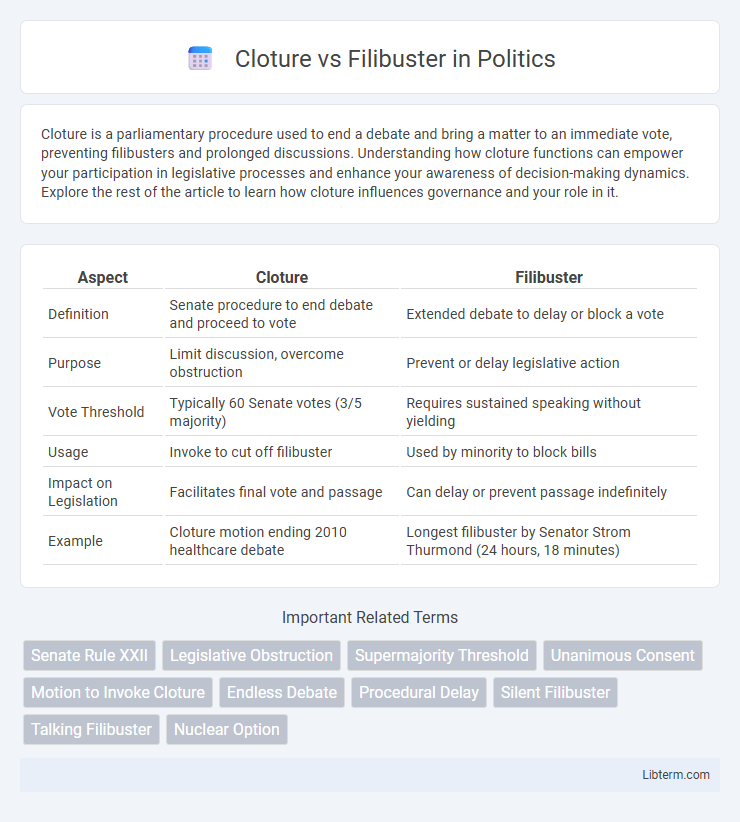Cloture is a parliamentary procedure used to end a debate and bring a matter to an immediate vote, preventing filibusters and prolonged discussions. Understanding how cloture functions can empower your participation in legislative processes and enhance your awareness of decision-making dynamics. Explore the rest of the article to learn how cloture influences governance and your role in it.
Table of Comparison
| Aspect | Cloture | Filibuster |
|---|---|---|
| Definition | Senate procedure to end debate and proceed to vote | Extended debate to delay or block a vote |
| Purpose | Limit discussion, overcome obstruction | Prevent or delay legislative action |
| Vote Threshold | Typically 60 Senate votes (3/5 majority) | Requires sustained speaking without yielding |
| Usage | Invoke to cut off filibuster | Used by minority to block bills |
| Impact on Legislation | Facilitates final vote and passage | Can delay or prevent passage indefinitely |
| Example | Cloture motion ending 2010 healthcare debate | Longest filibuster by Senator Strom Thurmond (24 hours, 18 minutes) |
Understanding Cloture and Filibuster
Cloture is a procedural motion in the United States Senate designed to end debate on a bill or nomination, requiring a supermajority vote of 60 out of 100 senators to proceed to a final vote. Filibuster is a tactic employed by senators to extend debate indefinitely, aiming to delay or block legislative action by preventing a vote. Understanding the interplay between cloture and filibuster is essential for comprehending how legislative efficiency and minority rights are balanced in the Senate.
Historical Origins of Cloture and Filibuster
Cloture originated in the U.S. Senate in 1917 as a formal procedure to end filibusters and limit debate, introduced after opponents blocked war-related legislation. The filibuster, dating back to the mid-19th century, initially emerged as an informal tactic allowing senators to prolong debate indefinitely to delay or block votes. These tools reflect evolving Senate rules designed to balance minority rights and legislative efficiency.
How the Filibuster Works in Practice
The filibuster allows senators to prolong debate indefinitely, effectively blocking a vote unless 60 senators vote for cloture to end discussion. In practice, this tactic is used to delay or prevent legislation by requiring a supermajority for most bills in the Senate. Filibusters force compromise or negotiation due to the high threshold needed for cloture to proceed to a final vote.
The Cloture Motion: Breaking a Filibuster
The Cloture motion is a parliamentary procedure used in the U.S. Senate to end a filibuster and bring a debate to a close, requiring a three-fifths majority vote, typically 60 out of 100 senators. Once invoked, cloture limits further debate to 30 additional hours before a final vote must be taken, effectively curtailing endless obstruction by filibustering senators. This mechanism is crucial for overcoming legislative gridlock and advancing bills or nominations that face prolonged delays.
Key Differences Between Cloture and Filibuster
Cloture and filibuster are procedural tools used in the U.S. Senate to manage debate on legislative proposals, with cloture serving as the mechanism to end a filibuster and bring the bill to a vote. A filibuster allows senators to extend debate indefinitely, effectively blocking or delaying legislation unless a supermajority of 60 senators votes for cloture to cut off debate. The key difference lies in their function: a filibuster prolongs debate to prevent a vote, while cloture limits debate to expedite the voting process.
Notable Filibusters in U.S. Senate History
Notable filibusters in U.S. Senate history include Senator Strom Thurmond's record-setting 24-hour and 18-minute speech against the Civil Rights Act of 1957, showcasing the filibuster's use as a delaying tactic. Senator Rand Paul's 13-hour filibuster in 2013 opposed drone strikes on American citizens without due process, highlighting modern policy debates empowered by this procedural tool. These instances demonstrate the filibuster's enduring role in shaping legislative outcomes and Senate debate dynamics.
The Evolution of Cloture Rules
Cloture rules have evolved significantly since their inception in the U.S. Senate in 1917, initially requiring a two-thirds majority to end debate and overcome filibusters. The threshold was lowered to three-fifths (60 senators) in 1975 to streamline legislative processes amid increasing use of filibusters. Recent reforms, such as the "nuclear option," have further altered cloture standards, particularly for judicial and executive nominations, reducing the required votes to a simple majority and reflecting ongoing efforts to balance debate and decisiveness.
Pros and Cons of Filibuster and Cloture
The filibuster allows minority senators to extend debate indefinitely, promoting thorough discussion and protecting minority rights, but it can also lead to legislative gridlock and prevent timely decision-making. Cloture, which limits debate to 30 hours and ends filibusters, enhances legislative efficiency and facilitates majority rule, yet it may suppress minority voices and reduce opportunities for detailed policy debate. Balancing the rights of the minority with the need for effective governance remains the central challenge in the use of filibuster and cloture within the U.S. Senate.
Cloture and Filibuster: Impact on Legislation
Cloture and filibuster are crucial Senate procedures that significantly influence legislative outcomes by controlling debate duration and the progression of bills. Cloture limits debate to 30 additional hours, effectively ending filibusters and enabling a final vote when supported by a three-fifths majority (typically 60 senators). Filibusters allow senators to extend debate indefinitely, often blocking legislation unless cloture is invoked, thereby impacting the Senate's ability to pass controversial or closely divided bills.
The Ongoing Debate Over Senate Rules
The ongoing debate over Senate rules centers on the balance between cloture and filibuster as tools for legislative decision-making. Cloture limits debate, requiring a three-fifths majority to end discussion and proceed to a vote, while the filibuster empowers minority senators to extend debate indefinitely, effectively blocking legislation. This tension impacts the Senate's efficiency, minority rights, and broader democratic processes, fueling continuous discussions on potential reforms.
Cloture Infographic

 libterm.com
libterm.com